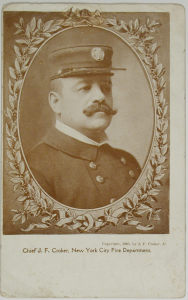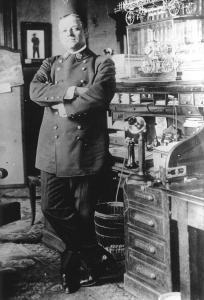It is difficult to sum up the career of Edward Franklin Croker in this limited amount of space. Appointed to the FDNY on June 22, 1884 at the age of twenty-one, he shocked everyone with his promotion to Assistant Foreman (now called Lieutenant) just forty-seven days later and with equal speed to Foreman (today’s Captain) on February 25, 1885. This rapid advancement was said to have been for one reason only; that he was the nephew of the most powerful political figure in New York City at the time, Richard Croker, head of Tammany Hall (who served as a fire commissioner 1883-1887.) And while this might be true, the fact was that over the next twenty-seven years, Chief Croker proved himself, time and time again, to be an outstanding firefighter and leader.
On January 22, 1892 Foreman Croker became Battalion Chief Croker. Being named Chief of Department on May 1, 1899, the specter of nepotism was cast upon him but he went on to fulfill his role with extreme diligence. He was the first Chief of Department who did not serve during the volunteer period. He was also the first Chief to use an automobile to respond to alarms.
In 1902, Chief Croker returned to work only several days into a two-month vacation. A vacation of such length was unusual but deemed justified for the hard-working Chief. In granting it, Commissioner Thomas Sturgis re-assigned other chiefs within the Department to cover Croker’s absence. But when Croker returned to work less than two weeks later and sent the chiefs back to the original assignments, the Commissioner saw it as an overstepping of bounds and a rescinding of the orders of a higher authority. Sturgis relieved Croker of command and preferred formal charges. A two-year court battle ensued with a final decision in Croker’s favor resulting in his re-instatement.
Croker epitomized the dichotomy of the fire service; that is to put their expertise to use in fire prevention. He was an outspoken advocate of improving fire safety throughout the City’s commercial and residential buildings. As early as 1894 he testified before the Tenement House Committee that a fatal fire was due, in part, to “the combustible nature of the building and its open construction.” The culmination of this was when he used the fatal sweatshop fire in Newark, New Jersey to once again call attention to the threat of such a catastrophe being repeated in New York. Just four months later it did at the Triangle Shirtwaist Company. As a result, he retired and turned over command of the Department on May 1 to Chief John Kenlon. Croker spent the next forty years in the fire prevention business. His company was a leader in the field and exists to today. In 1912 he authored the seminal book, “Fire Prevention.”
His life was both colorful and tumultuous. Family history not withstanding, he was the frequent subject of news coverage as much for his personal life as for his position in the fire department. He went through a contentious separation from his wife in 1908, though they never divorced. In 1914 he built a “completely fire-proof” house in Long Beach, Long Island, said to be the first of its kind in the country. The house warming party he held there was covered in the New York Times.
Chief Croker was a resident of Amityville, Long Island when he died on February 7, 1951 of chronic myocarditis at Tenderling Nursing Home in Lindenhurst. His body was cremated and his remains were turned over to his estranged wife. Their final disposition of are unknown.
Chief Croker’s maternal grandfather was Thomas Franklin who was a member of the NYFD beginning in 1783, serving as Chief from 1811 through 1824.

